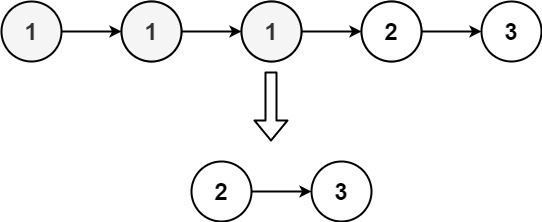LeetCode:82. 删除排序链表中的重复元素 II(C++、Java)
发布时间:2024年01月15日
目录
82. 删除排序链表中的重复元素 II
题目描述:
????????给定一个已排序的链表的头?head?,?删除原始链表中所有重复数字的节点,只留下不同的数字?。返回?已排序的链表?。
示例 1:

输入:head = [1,2,3,3,4,4,5] 输出:[1,2,5]
示例 2:

输入:head = [1,1,1,2,3] 输出:[2,3]
提示:
- 链表中节点数目在范围?
[0, 300]?内 -100 <= Node.val <= 100- 题目数据保证链表已经按升序?排列
实现代码与解析:
链表遍历:
C++
/**
* Definition for singly-linked list.
* struct ListNode {
* int val;
* ListNode *next;
* ListNode() : val(0), next(nullptr) {}
* ListNode(int x) : val(x), next(nullptr) {}
* ListNode(int x, ListNode *next) : val(x), next(next) {}
* };
*/
class Solution {
public:
ListNode* deleteDuplicates(ListNode* head) {
ListNode* dummy = new ListNode();
dummy->next = head;
ListNode* cur = dummy;
while (cur->next && cur->next->next) {
if (cur->next->val == cur->next->next->val) {
int t = cur->next->val; // 可能不止一个相同的,记录下来再找
while (cur->next && cur->next->val == t) {
cur->next = cur->next->next;
}
} else {
cur = cur->next;
}
}
return dummy->next;
}
};java
/**
* Definition for singly-linked list.
* public class ListNode {
* int val;
* ListNode next;
* ListNode() {}
* ListNode(int val) { this.val = val; }
* ListNode(int val, ListNode next) { this.val = val; this.next = next; }
* }
*/
class Solution {
public ListNode deleteDuplicates(ListNode head) {
ListNode dummy = new ListNode();
dummy.next = head;
ListNode cur = dummy;
while (cur.next != null && cur.next.next != null) {
if (cur.next.val == cur.next.next.val) {
int t = cur.next.val;
while (cur.next != null && cur.next.val == t) {
cur.next = cur.next.next;
}
} else {
cur = cur.next;
}
}
return dummy.next;
}
}实现代码与解析:
? ? ? ? 首先,这种链表题一般都要创建一个虚拟头节点,dummy,因为它给的头节点可能也是需要删除的,定义了虚拟头节点这样代码好写,不用再考虑那么多极限情况,遍历起来也方便。
? ? ? ? 给定的链表是有序的,考虑到重复的都需要删除,而不是留一个,所以,我们需要同时遍历三个节点,后两个用于遍历对比,前一个用来执行不需要删除的节点。
? ? ? ? 如果找到了相同节点,注意重复的节点可能不止只有两个,所以要用while持续判断,同时改变节点的指向。
? ? ? ? 注意,最后返回的是dummy节点的下一个节点,而不是head,可能head已经逻辑上删除了。
文章来源:https://blog.csdn.net/Cosmoshhhyyy/article/details/135607389
本文来自互联网用户投稿,该文观点仅代表作者本人,不代表本站立场。本站仅提供信息存储空间服务,不拥有所有权,不承担相关法律责任。 如若内容造成侵权/违法违规/事实不符,请联系我的编程经验分享网邮箱:chenni525@qq.com进行投诉反馈,一经查实,立即删除!
本文来自互联网用户投稿,该文观点仅代表作者本人,不代表本站立场。本站仅提供信息存储空间服务,不拥有所有权,不承担相关法律责任。 如若内容造成侵权/违法违规/事实不符,请联系我的编程经验分享网邮箱:chenni525@qq.com进行投诉反馈,一经查实,立即删除!
最新文章
- Python教程
- 深入理解 MySQL 中的 HAVING 关键字和聚合函数
- Qt之QChar编码(1)
- MyBatis入门基础篇
- 用Python脚本实现FFmpeg批量转换
- 八股文打卡day13——计算机网络(13)
- Nature | 化学领域的ChatGPT:人工智能与机器人联合打造新材料
- HTML5+CSS3+JS小实例:网页手电筒
- 使用MySQL的过程中,有没有遇到过count()比较慢的情况?
- Flink 2.0 状态管理存算分离架构演进
- 轻松搞定!微信快速统计数据报表妙招
- 零基础学习数学建模——(一)什么是数学建模
- linux系统下可用的语音转文字方法(Fish Speech)
- 数据库:JDBC、自定义工具类、SQL注入问题
- 什么?Figma 的 fig 文件格式居然被破解出来了